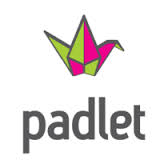
Padlet boasts that their platform is “the easiest way to create and collaborate in the world”. A rather presumptuous statement if you think about it.
For that reason we decided to test it for ourselves and you can also let us know if their statement is accurate or just too optimistic. Can Padlet be used on an academic level or even within other areas within the university? Have a look at our own Bits & Bytes Padlet-page and leave us a message. (You can do this anonymously or leave your name)
But first – what is Padlet?
This seemingly simple platform gives educators, for example lecturers and teachers and learners or students a virtual bulletin board on which they can air their opinions and thoughts on a topic to their heart’s content. It almost works like a traditional board, but with much more functionality. For example, a lecturer can ask a question in class, paste it on a wall and students can comment and collaborate on it during class. You can even load graphics, files, as well as links.
Padlet does have a few handy options to customise your wall just the way you prefer it. Whether you want to change the background or assign specific rights to a particular person. You can even get a QR-code for your site/wall and Padlet is extremely smart phone and tablet friendly.
If you’re interested in what Padlet can be used for, also read Shaun Takenouchi’s article.
Padlet provides educators and learners a virtual platform on which to collaborate on a specific topic.
Padlet is a virtual wall that allows people to express their thoughts on a common topic easily. It works like an online sheet of paper where people can put any …
Padlet is the easiest way to create and collaborate in the world
Welcome to Padlet, possibly the easiest way to create and collaborate in the world.
In a nutshell, Padlet is an online bulletin board. History teachers, however, can use this tool in myriad ways. For example, Padlet users can pose open-ended questions and elicit multiple student responses—ideal for posing document-based questions using primary sources.
http://teachinghistory.org/digital-classroom/tech-for-teachers/24636

Padlet spog dat hulle platform (moontlik) die maklikste manier ter wereld is vir `n groep mense om saam te werk en skep. Nogal `n redelik brawe stelling, sou `n mens dink.
Ons het dit self gaan toets en sal graag wil hoor wat jy daarvan dink. Kan dit op `n akademiese vlak gebruik word vir studente of dalk selfs binne ander omgewings binne die universiteit? Gaan loer gerus by ons eie Bits & Bytes Padlet-bladsy en los vir ons kommentaar. (Jy kan dit anoniem doen of jou naam bysit)
Maar eers – wat is Padlet?
Die klaarblyklik eenvoudige platform bied aan opvoeders, byvoorbeeld lektore en onderwysers en leerders of studente `n virtuele aansteekbord waarop hulle na hartelus hul gedagtes en opinies oor `n geselekteerde onderwerp kan lug. Dit werk soos `n tradisionele aansteekbord, behalwe dat dit meer funksionaliteit bied. `n Dosent kan byvoorbeeld tydens `n klas `n bord skep, `n vraag vra en studente kan aanlyn tydens die klas op Padlet kommentaar en insette lewer. Jy kan selfs grafika en leers laai, sowel as skakels plaas.
Wat Padlet wel handig maak is dat dit `n verskeidenheid opsies bied om jou bladsy te pasmaak soos jy dit verkies. Of jy die agtergrond wil verander of verskeie regte toeken aan verskeie persone. Jy kan self `n QR-kode gebruik vir jou bladsy, dus is dit heeltemal selfoon- en veral ook tablet-vriendelik. Indien jy belangstel in wat Padlet nog te bied het, lees gerus Shaun Takenouchi se artikel.
Tags: Research

